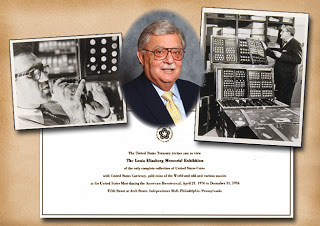
In this and our next two issues, Harvey Stack remembers his part in creating a memorable exhibit at the United States Mint in Philadelphia as part of our nation’s 1976 Bicentennial Celebration.
The Eliasberg Collection
This is a story that is not to well known, of how a great numismatic collection, helped save the Smithsonian Exhibition during the 1976 Bicentennial Celebration of the United States. The great collection I refer to was the famous Louis E. Eliasberg Collection, part of my early life and experience in numismatics and the only complete collection of United States coins ever formed.
The Stack family in 1941 helped Mr. Eliasberg acquire for the sum of $110,000 the noted Clapp Collection which had been formed and housed in Washington DC. From that point on, virtually every addition to the collection came from Stack’s.
Mr. Eliasberg was a very proud collector who loved to exhibit his collection to friends and others, mostly in Baltimore. He was a banker and financier and on the boards of many Maryland banks. Whenever a bank he was connected with had a celebration, anniversary or just wanted to attract people, Louis Eliasberg would display his collection, usually in the center halls of the bank with prepared booklets about the collection. He provided the money of the United States as an educational display, which usually lasted several weeks.
For those of you who never saw the collection on display, it was housed in large, vertical frames, on large rotating type stands, so that each side of the coin was visible to show the design, date on the obverse, and the mint marks on the reverse. These displays, first conceived by Eliasberg in the early 1950s, still could be used until the day the collection was finally sold. Tens of thousands of collectors saw the displays and were influenced to pursue collecting with the same profound interest and desires that motivated Louis Eliasberg.
Louis Eliasberg was a very active collector, and attended many meetings of the Baltimore coin clubs and regional and national conventions to learn as much as he could about the coins of the United States.
In the early 1970s Louis Eliasberg decided that he might be able to do no more with his collection. He felt that some large bank would want to acquire it for a permanent display or some large public corporation would like to use it to attract more people to their products. Having many friends in the Wall Street area, he took his idea to them, but they did not understand what he was asking them to do.
He felt that the collection could be displayed nationwide by using the railroads as moveable showcases. This idea had been used several times in the past, and Mr. Eliasberg envisioned that a pair of railroad cars could be outfitted as display vehicles to house the coins. The cars would be parked in the largest railroad stations in America for periods of one or two weeks at a time, and the public would be able to view the coins in "their own backyards." By 1973 my cousin Norman Stack and I (as our parents were getting older) were given the job of working directly with Mr. Eliasberg. We went to Baltimore, to further discuss his concept with him. We reviewed the collection several times and made suggestions as to how brochures could be presented to make the public more aware of United States coinage. Our discussions lasted for hours and after we left Louis Eliasberg pursued his idea and project. Unfortunately, he became ill and could not pursue the project to its end.
A Frantic Call for Help
Also in 1973 we received a somewhat frantic call from the curators of the Smithsonian, Dr. and Mrs. Stefanneli, who we had known for decades and had worked with on the National Collection. The United States Mint wanted the Mint Collection, which had been given to the Smithsonian Institution, returned. They wanted those specimens for display at the new Mint being built in Philadelphia, which would open in 1976, the Bicentennial year. The Smithsonian had already planned to incorporate the coins of the Mint Cabinet (which they had on display, along with the J.K. Lilly Collection, and other great American coins) in their own exhibit during the Bicentennial Celebration.
In order to honor and celebrate America’s 200th year in 1976, most famous sites were being refinished and refurbished. This was especially true in Philadelphia, where the famous Constitution Hall, the Liberty Bell, and other cherished landmarks and sites from our early history were being made fresh and inviting to attract millions of visitors. To further acknowledge Philadelphia, it was decided to build a new Mint there as well. However, the planners realized that they did not have anything of great importance or recognition to display within the walls of the new Mint.
Thus, they wanted the coins they gave to the Smithsonian returned! “No way,” said the Smithsonian! “Our way,” said the Mint! The frantic call we received from the Smithsonian was a result of this dilemma. "Can you help us think how we can avoid a conflict?” “How could we fight the Treasury Department (the parent of the Mint)?” Could Stack’s help with this problem?





